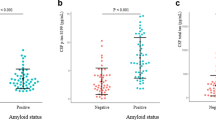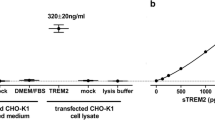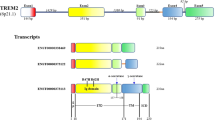Abstract
Background/aims
Recently, we showed that triggering receptor expressed on myeloid cells 1 (TREM1) was involved in the pathogenesis of Alzheimer’s disease (AD) since it modulated microglial phagocytic functions and thus affected amyloid-β clearance in the brain. Interestingly, a soluble form of TREM1 (sTREM1) can be detected in the plasma of human. To date, whether sTREM1 concentrations were altered in the plasma under AD context remained unclear.
Methods
In this study, we compared the plasma concentrations of sTREM1 between 110 AD patients and 128 age- and gender-matched controls. Meanwhile, the relationship of sTREM1 concentrations with total tau levels in the plasma of AD patients was also assessed.
Results
We revealed that the concentrations of sTREM1 were significantly increased in AD patients. Meanwhile, the sTREM1 concentrations were gradually increased during disease progression. More importantly, we showed that the sTREM1 concentrations were positively correlated with the levels of total tau in the plasma of AD patients (r = 0.61, P < 0.001). The subsequent subgroup analysis indicated that this correlation was more pronounced in patients with severe dementia (Mini-Mental State Exam score < 10, r = 0.81, P < 0.01).
Conclusion
These findings indicate a potential association between sTREM1 and tau pathology, and further confirm an involvement of this immune receptor in AD pathogenesis.
Similar content being viewed by others
Avoid common mistakes on your manuscript.
Introduction
Alzheimer’s disease (AD) is the most common cause of dementia in people over the age of 65 [1]. Currently, the pathogenesis of AD is still unclear, and no effective strategy is available for the treatment of this disease [2]. Amyloid-β (Aβ) accumulation and tau pathology represent the two main hallmarks of AD, and it has been proven that these two pathological changes manifested decades before the appearance of clinical symptoms [3]. Hence, to identify individuals at early stages for timely intervention and to uncover the potential disease pathogenesis, reliable plasma biomarkers are needed.
Previously, Replogle and colleagues revealed a close association between triggering receptor expressed on myeloid cells 1 (TREM1) gene and AD, as its intronic variant rs6910730G was related to an increased Aβ level as well as total amyloid burden in the brains of elderly subjects [4]. TREM1 encodes a type I transmembrane immune receptor, which is expressed by a subset of myeloid cells including leukocyte and microglia [5]. Recently, Sao and colleagues revealed that TREM1 expression was increased in the leukocyte of AD patients [6]. Moreover, we showed that TREM1 modulated microglial phagocytic functions and thus facilitated Aβ clearance in the brain of APP/PS1 mice, an animal model of AD [7]. In the plasma, a soluble form of TREM1 (sTREM1) can be detected using commercial detection kits [8]. The concentrations of sTREM1 were markedly elevated in patients with systemic sepsis, acute myocardial infarction and subarachnoid hemorrhage, and were considered as a potential plasma biomarker for these diseases [9,10,11]. However, whether sTREM1 concentrations were altered in the plasma under AD context remained unclear.
In this study, we assessed the concentrations of sTREM1 in the plasma of 110 AD patients and 128 age- and gender-matched controls. We showed that the concentrations of sTREM1 were significantly increased in AD patients. Meanwhile, the sTREM1 concentrations were gradually increased during disease progression. More importantly, we revealed the sTREM1 concentrations were positively correlated with the levels of total tau (t-tau) in the plasma of AD patients. The subsequent subgroup analysis indicated that this correlation was more pronounced in patients with severe dementia. These findings indicate a potential association between sTREM1 and tau pathology, and further confirm an involvement of this immune receptor in the pathogenesis of AD.
Materials and methods
Human subjects and plasma collection
A total of 110 AD patients and 128 cognitively normal controls matched for age (mean age of AD patients vs. cognitively normal controls: 74.48 ± 5.86 vs. 74.60 ± 7.97; P = 0.91) and gender (female % of AD patients vs. cognitively normal controls: 58.9% vs. 55.1%; P = 0.84) were involved in this study. The details of this cohort were described in our previous study (also see Table 1) [12]. Briefly, the AD patients were recruited from the Department of Neurology at Qingdao Municipal Hospital. A consensus clinical diagnosis of probable AD was established according to the criteria of the National Institute of Neurological and Communicative Disorders and Stroke/Alzheimer’s Disease and Related Disorders Association by at least two neurologists as described [13], and the severity of dementia was assessed by Mini-Mental State Exam (MMSE). The cognitively normal controls matched for age and gender were collected from the Health Examination Centers of collaborating hospitals in Qingdao and Nanjing as described [12]. They were confirmed healthy and neurologically normal by physicians. It should be noted that subjects with ischemic heart disease, chronic obstructive pulmonary disease, rheumatoid arthritis, colitis, end-stage renal disease and a recent history of infectious diseases were excluded from this study, as these diseases may potentially affect sTREM1 concentrations in plasma.
Plasma collection was performed as described [12]. Briefly, venous blood (5 mL) was collected at room temperature in 0.9% sodium citrate and centrifuged at 3000g for 20 min. Aliquots of plasma were frozen in liquid nitrogen and stored at − 40 °C until use.
Measurement of sTREM1 and t-tau levels
Plasma concentrations of sTREM1 were determined by enzyme-linked immunoabsorbent assay (ELISA) as described by Boufenzer and colleagues [10]. The levels of t-tau in the plasma were evaluated via a specific ELISA kit (Abcam Inc.) according to the manufacturer’s instructions.
Statistical analysis
Statistical analysis was performed by GraphPad Prism 6 (GraphPad Software). Independent sample t test or one-way analysis of variance (ANOVA) followed by Tukey’s post hoc test was used to analyze differences between different groups. Pearson’s correlation analysis was used to investigate the correlation between sTREM1 and t-tau levels. All data were expressed as mean ± SD. P < 0.05 was considered statistically significant.
Results
First, the concentrations of sTREM1 in the plasma of AD patients and their age- and gender-matched controls were detected using ELISA. As revealed by Fig. 1a, AD patients showed significantly higher sTREM1 concentrations when compared with cognitively normal controls (60.34 ± 14.94 pg/mL vs. 52.09 ± 13.54 pg/mL, P < 0.001). Afterward, to investigate whether plasma sTREM1 concentrations were altered during disease progression, AD patients were divided into three subgroups according to disease severity: 7 patients with mild dementia (20 ≤ MMSE < 24), 94 patients with moderate dementia (10 ≤ MMSE < 20) and 9 patients with severe dementia (MMSE < 10). As shown by Fig. 1b, the concentrations of sTREM1 in the plasma of AD patients were gradually increased during disease progression (P < 0.001). In addition, we assessed the levels of t-tau, a potential AD biomarker, in the plasma of AD patients and their age- and gender-matched controls. The t-tau levels in the plasma of AD patients were significantly higher than those of cognitively normal controls (Fig. 1c, 26.14 ± 11.52 pg/mL vs. 15.02 ± 9.04 pg/mL, P < 0.001).
The concentrations of sTREM1 and t-tau are significantly increased in the plasma of AD patients. a The concentrations of sTREM1 in the plasma of AD patients and their age- and gender-matched controls were detected using ELISA. Data were analyzed using independent sample t test. b Next, AD patients were divided into three subgroups according to disease severity: 7 patients with mild dementia (20 ≤ MMSE < 24), 94 patients with moderate dementia (10 ≤ MMSE < 20) and 9 patients with severe dementia (MMSE < 10). The concentrations of sTREM1 in the plasma were detected through ELISA. Data were analyzed using one-way analysis of variance (ANOVA) followed by Tukey’s post hoc test. c The levels of t-tau in the plasma of AD patients and their age- and gender-matched controls were detected via ELISA. Data were analyzed using independent sample t test. All data were expressed as mean ± SD
Next, to determine the correlation between the concentrations of sTREM1 and t-tau levels in the plasma of AD patients, Pearson’s correlation analysis was performed. As demonstrated by Fig. 2a, plasma sTREM1 concentrations were positively correlated with t-tau levels in AD patients (r = 0.61, P < 0.001). Meanwhile, the subsequent subgroup analysis showed the correlation between plasma sTREM1 concentrations and t-tau levels was more pronounced in patients with severe dementia (MMSE < 10, Fig. 2b, r = 0.81, P < 0.01).
The concentrations of sTREM1 are positively correlated with t-tau levels in the plasma of AD patients. a Pearson’s correlation analysis was employed to investigate the correlation between plasma sTREM1 concentrations and the levels of t-tau in all AD patients. b Pearson’s correlation analysis was employed to investigate the correlation between plasma sTREM1 concentrations and the levels of t-tau in patients with severe dementia (MMSE < 10)
Discussion
As a type I transmembrane immune receptor, TREM1 is expressed by a subset of myeloid cells including microglia and monocytes, coupling with adapter protein TYROBP for its signaling and biologic functions [8, 14]. Emerging evidence indicated that a soluble form of TREM1 can be detected in the plasma of human and rodent [8], although its origin remains unclear. Several lines of evidence indicated that sTREM1 was derived from proteolytic cleavage or membrane shedding of full-length TREM1 [15], while some researchers showed that it can be generated by the translation of an alternative TREM1 mRNA splice variant [16]. Increased plasma sTREM1 concentrations have been noted in specific diseases including systemic sepsis, acute myocardial infarction and subarachnoid hemorrhage, and were considered as a useful diagnostic marker for these diseases [9,10,11]. In the current study, we demonstrated that plasma sTREM1 concentrations were significantly increased under AD context. Meanwhile, we showed that the plasma concentrations of sTREM1 in AD patients were gradually increased during disease progression. Since plasma sTREM1 concentrations indirectly reflected TREM1 activation [17], this result supported our previous findings that the activation of TREM1 participated in the pathogenesis and progression of AD.
Tau is a microtubule-associated protein that promotes microtubule assembly and stabilization [18]. Under AD context, tau is abnormally hyperphosphorylated by several tau kinases and is considered as a main pathological hallmark of this disease [19]. Due to the disruption of brain–blood barrier during AD progression, tau leaks from cerebrospinal fluid to the plasma [20]. Several lines of evidence suggested that plasma t-tau levels might represent a potential biomarker for this disease since it was closely associated with cognitive impairment and brain atrophy and metabolism [21]. In this study, we showed that the plasma t-tau levels were significantly increased in AD patients. This result was consistent with previous findings that AD patients had higher plasma t-tau levels when compared with healthy controls [22, 23]. More importantly, using Pearson’s correlation analysis, we provided evidence that plasma sTREM1 concentrations were positively correlated with t-tau levels in AD patients. The subsequent subgroup analysis indicated that this correlation was more pronounced in patients with severe dementia (MMSE < 10). To our knowledge, this is the first study reporting a correlation between sTREM1 and t-tau levels in the plasma under AD context. In consideration of this finding, we speculated that TREM1 may participate in the pathogenesis and progression of AD via influencing tau pathology, especially at the late stage of this disease. Future studies are warranted to validate this hypothesis.
The current study also has some limitations. Since cerebrospinal fluid (CSF) biomarkers usually reflect brain pathological changes more precisely than those in plasma, we will continue to investigate whether a corresponding alteration of sTREM1 concentrations happened in the CSF during disease progression in future. Moreover, in addition to AD patients, our future studies will focus on mild cognitive impairment subjects to further uncover the role of sTREM1 at the very early stage of this disease.
In conclusion, we assessed the concentrations of sTREM1 in the plasma of 110 AD patients and 128 age- and gender-matched controls in this study. We revealed that the concentrations of sTREM1 were significantly increased in AD patients. Meanwhile, the sTREM1 concentrations were gradually increased during disease progression. More importantly, we showed that the sTREM1 concentrations were positively correlated with the levels of t-tau in the plasma of AD patients. The subsequent subgroup analysis indicated that this correlation was more pronounced in patients with severe dementia. These findings indicate a potential association between sTREM1 and tau pathology, and further confirm an involvement of this immune receptor in the pathogenesis of AD.
References
Jiang T, Yu JT, Tian Y et al (2013) Epidemiology and etiology of Alzheimer’s disease: from genetic to non-genetic factors. Curr Alzheimer Res 10:852–867
Scheltens P, Blennow K, Breteler MM et al (2016) Alzheimer’s disease. Lancet 388:505–517. https://doi.org/10.1016/S0140-6736(15)01124-1
Jiang T, Yu JT, Tan L (2012) Novel disease-modifying therapies for Alzheimer’s disease. J Alzheimer’s Dis JAD 31:475–492. https://doi.org/10.3233/JAD-2012-120640
Replogle JM, Chan G, White CC et al (2015) A TREM1 variant alters the accumulation of Alzheimer-related amyloid pathology. Ann Neurol 77:469–477. https://doi.org/10.1002/ana.24337
Saadipour K (2017) TREM1: a potential therapeutic target for Alzheimer’s disease. Neurotox Res 32:14–16. https://doi.org/10.1007/s12640-017-9716-y
Sao T, Yoshino Y, Yamazaki K et al (2018) TREM1 mRNA expression in leukocytes and cognitive function in Japanese patients with alzheimer’s disease. J Alzheimer’s Dis JAD 64:1275–1284. https://doi.org/10.3233/JAD-180418
Jiang T, Zhang YD, Gao Q et al (2016) TREM1 facilitates microglial phagocytosis of amyloid beta. Acta Neuropathol 132:667–683. https://doi.org/10.1007/s00401-016-1622-5
Jeremie L, Amir B, Marc D et al (2015) The triggering receptor expressed on myeloid cells-1: a new player during acute myocardial infarction. Pharmacol Res 100:261–265. https://doi.org/10.1016/j.phrs.2015.07.027
Charles PE, Noel R, Massin F et al (2016) Significance of soluble triggering receptor expressed on myeloid cells-1 elevation in patients admitted to the intensive care unit with sepsis. BMC Infect Dis 16:559. https://doi.org/10.1186/s12879-016-1893-4
Boufenzer A, Lemarie J, Simon T et al (2015) TREM-1 mediates inflammatory injury and cardiac remodeling following myocardial infarction. Circ Res 116:1772–1782. https://doi.org/10.1161/CIRCRESAHA.116.305628
Sun XG, Ma Q, Jing G et al (2017) Early elevated levels of soluble triggering receptor expressed on myeloid cells-1 in subarachnoid hemorrhage patients. Neurol Sci 38:873–877. https://doi.org/10.1007/s10072-017-2853-5
Jiang T, Tan L, Gao Q et al (2016) Plasma angiotensin-(1–7) is a potential biomarker for Alzheimer’s disease. Curr Neurovascular Res 13:96–99
McKhann G, Drachman D, Folstein M et al (1984) Clinical diagnosis of Alzheimer’s disease: report of the NINCDS-ADRDA Work Group under the auspices of Department of Health and Human Services Task Force on Alzheimer’s Disease. Neurology 34:939–944
Klesney-Tait J, Turnbull IR, Colonna M (2006) The TREM receptor family and signal integration. Nature Immunol 7:1266–1273. https://doi.org/10.1038/ni1411
Gibot S, Kolopp-Sarda MN, Bene MC et al (2004) A soluble form of the triggering receptor expressed on myeloid cells-1 modulates the inflammatory response in murine sepsis. J Exp Med 200:1419–1426. https://doi.org/10.1084/jem.20040708
Begum NA, Ishii K, Kurita-Taniguchi M et al (2004) Mycobacterium bovis BCG cell wall-specific differentially expressed genes identified by differential display and cDNA subtraction in human macrophages. Infect Immun 72:937–948
Gomez-Pina V, Soares-Schanoski A, Rodriguez-Rojas A et al (2007) Metalloproteinases shed TREM-1 ectodomain from lipopolysaccharide-stimulated human monocytes. J Immunol 179:4065–4073
Guo T, Noble W, Hanger DP (2017) Roles of tau protein in health and disease. Acta Neuropathol 133:665–704. https://doi.org/10.1007/s00401-017-1707-9
Orr ME, Sullivan AC, Frost B (2017) A brief overview of tauopathy: causes, consequences, and therapeutic strategies. Trends Pharmacol Sci 38:637–648. https://doi.org/10.1016/j.tips.2017.03.011
Montagne A, Zhao Z, Zlokovic BV (2017) Alzheimer’s disease: a matter of blood-brain barrier dysfunction? J Exp Med 214:3151–3169. https://doi.org/10.1084/jem.20171406
Mattsson N, Zetterberg H, Janelidze S et al (2016) Plasma tau in Alzheimer disease. Neurology 87:1827–1835. https://doi.org/10.1212/WNL.0000000000003246
Olsson B, Lautner R, Andreasson U et al (2016) CSF and blood biomarkers for the diagnosis of Alzheimer’s disease: a systematic review and meta-analysis. Lancet Neurol 15:673–684. https://doi.org/10.1016/S1474-4422(16)00070-3
Mielke MM, Hagen CE, Wennberg AMV et al (2017) Association of plasma total tau level with cognitive decline and risk of mild cognitive impairment or dementia in the mayo clinic study on aging. JAMA Neurol 74:1073–1080. https://doi.org/10.1001/jamaneurol.2017.1359
Acknowledgements
This work was supported by National Natural Science Foundation of China (81501092), Natural Science Foundation of Jiangsu Province (BK20150091), “Six Talent Summit” Foundation of Jiangsu Province (2016-WSN-180), Youth Medical Talent Program of Jiangsu Province (QNRC2016068), Medical Innovation Team of Jiangsu Province (CXTDA2017030), and Nanjing Medical Science and Technology Development Foundation for Distinguished Young Scholars (JQX17008).
Author information
Authors and Affiliations
Corresponding authors
Ethics declarations
Conflict of interest
The authors confirm that this article has no conflict of interest.
Ethical approval
All procedures performed in studies involving human participants were in accordance with the ethical standards of Qingdao Municipal Hospital and with the 1964 Helsinki declaration and its later amendments or comparable ethical standards.
Informed consent
A written informed consent was obtained from each participant or the legal guardian.
Additional information
Publisher’s Note
Springer Nature remains neutral with regard to jurisdictional claims in published maps and institutional affiliations.
Rights and permissions
About this article
Cite this article
Jiang, T., Gong, PY., Tan, MS. et al. Soluble TREM1 concentrations are increased and positively correlated with total tau levels in the plasma of patients with Alzheimer’s disease. Aging Clin Exp Res 31, 1801–1805 (2019). https://doi.org/10.1007/s40520-019-01122-9
Received:
Accepted:
Published:
Issue Date:
DOI: https://doi.org/10.1007/s40520-019-01122-9






